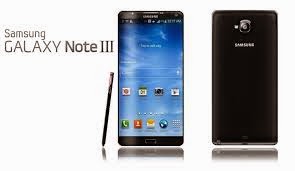 When the original Samsung Galaxy Note first appeared, we weren’t sure big-screened smartphones would take off; three years on, with the release of the third-generation Samsung Galaxy Note 3, it would seem the giant-sized smartphone has finally come of age. See also: the 11 best smartphones of 2014.
When the original Samsung Galaxy Note first appeared, we weren’t sure big-screened smartphones would take off; three years on, with the release of the third-generation Samsung Galaxy Note 3, it would seem the giant-sized smartphone has finally come of age. See also: the 11 best smartphones of 2014.As with the previous version, the Samsung Galaxy Note 3 initially looks much like its smaller sibling, the Galaxy S4, with its chrome trim and slender bezel. Overall, though, we prefer the design of the Note 3, and this is largely due to the soft, fake-leather rear; it sounds naff, but it actually gives the Note a noticeably less cheap feel than the S4. Plus, it’s easier to grip than glossy plastic – something that comes in useful in a smartphone this big.
Stick them side by side, though, and you’ll instantly see the big difference: the Note sports a much larger, 5.7in display than the S4; in fact it’s also larger than its predecessor, the Note II, by 0.2in. And in a feat that would make the TARDIS proud, the Note 3’s physical dimensions have actually shrunk: it’s a millimetre thinner, ever-so-slightly narrower across its waist, and 15g lighter than the previous model.
That’s a remarkable feat of engineering, made even more amazing when you realise that, in almost every department, the Note 3 is a significant advance on its predecessor. The larger Super AMOLED display, for instance, is now a Full HD 1,920 x 1,080 unit; it’s fully 4G-compatible; the rear camera has been upgraded from 8 megapixels to 13 megapixels with the ability to shoot 4K video; and the upgraded quad-core 2.3GHz Qualcomm Snapdragon 800 CPU is accompanied by 3GB of RAM.
Plus, there’s a host of other niceties on offer, including a USB 3 host socket on the bottom edge for quicker transfer of those large, 4K video clips, an infrared port for controlling your TV or set-top box with, and three extra sensors for temperature, humidity and gesture recognition. The Note 3 also sports a removable battery and microSD slot for storage expansion. That’s not forgetting Samsung’s active stylus technology: the S Pen stows away in the bottom-right edge of the device, and adds pressure-sensitive sketching and painting, note jotting and handwriting recognition.
Despite the Note 3’s smaller dimensions, battery capacity hasn’t suffered. Samsung has managed to cram in a slightly higher-capacity 3,200mAh unit, and this retained 70% capacity after our 24-hour rundown test – an impressive result, but a notch down on the previous model. In our experience this was enough to deliver one-and-a-half days’ worth of use reliably – sometimes even more, with moderate use. Even if we used the phone heavily for games, shooting video and downloading large amounts of data, we were able to rely on it making it through a full day.
It all adds up to what is a fabulous, luxurious-feeling smartphone. It’s ridiculously fast in general use, super smooth when browsing the web and swats demanding games aside with ease. We ran our usual set of mobile benchmarks, and the results backed up our initial impressions: the Note 3 dispatched the SunSpider benchmark in a mere 591ms; racked up a score of 4,002 in Geekbench and 916 in the Peacekeeper HTML test; and achieved a smooth average of 26fps in the demanding GFXBench T-Rex HD test.
The camera is excellent, producing crisp, well-balanced shots under virtually all lighting conditions, and it sports a superb macro mode. All the novelty camera features offered by the Galaxy S4, such as Best Face (where the camera shoots a sequence, and allows you to choose the best face from each person in a group shot), and Dual Shot (where the camera will record from both front- and rear-facing camera at the same time) are present, too. Only when it becomes really dim does noise start to impose on images in a distracting manner. The Nokia Lumia 1020 retains the edge for all-round snapping ability, but the Note 3’s low-light photos are slightly better than the Galaxy S4’s, with more contrast and less noise.
Video is more of a mixed bag. The Note 3 will shoot 4K video, but only for five minutes at a time, and you’ll need a Retina-style display to make the most of all those pixels anyway. Video quality isn’t amazing, either: clips looked a little flat and lacking in contrast; autofocus wasn’t hugely reliable unless we tapped the screen to refocus; and the stabilisation smoothed out big movements but obscured fine detail as it did so.
Viewing video and editing photos, however, on the Note 3’s 5.7in, Full HD display is an absolute pleasure. The Super AMOLED panel serves up rich, saturated colours and perfect black. Maximum brightness, as with most AMOLED screens, isn’t as good as the iPhone 5s’ IPS display, but a measured 338cd/m2 makes it among the brightest panels we’ve seen of its type.
It’s true that using the Note 3 one-handed is a challenge. We found we couldn’t reach the left edge of the display with the phone held in one hand, let alone the top-left and bottom-left corners. Samsung’s one-handed mode does help matters – this shrinks the Android desktop and docks it to either side of the screen for more comfortable left- or right-handed usage – but the swipe required to activate it is tricky to perform reliably with one hand. Meanwhile, stick it in a jeans pocket and the sheer size of the handset means that it will jab uncomfortably into your hip whenever you bend over to pick something up.
It’s also pretty pricey, at £585, with contract prices starting at £34 per month for a free phone deal. Our current favourite smartphone – the HTC One – is far cheaper.
That, coupled with the sheer size of the Samsung Galaxy Note 3, is just enough to knock it out of contention for our top A-List spot. But if you can live with its pocket-bulging dimensions, the slick performance, superb battery life and great camera – coupled with the huge screen and stylus – make it a hugely appealing handset.







wah mantep nih artikelnya gan
ReplyDeletemampir ya gan https://goo.gl/eoHSSb